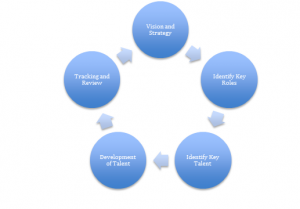Succession planning in SME’s: Can you afford not too?
A report in 2017 found that 61 per cent of UK SMEs – equating to 3.4 million UK firms with fewer than 250 employees – have no clear plan in place to ensure that their businesses do not suffer when key staff leave.
The CIPD defines succession planning as the process of identifying and developing potential future leaders or senior managers, as well as individuals to fill other business-critical positions, either in the short- or the long-term.
Succession planning is no longer the preserve of the large corporate organisation – in fact, it is arguably more important within an SME, where resource is smaller and knowledge is held by fewer people. What would happen to your business if one or more key team members were suddenly absent? The importance of succession plans is even more significant if your business has ambitious growth plans, because the impact of failing to have a plan in place as insurance in the event of the unexpected people transitions, represents a significant business risk. The benefits of planning for succession are clear, and include the following:
Continuity: a means to ensure business continuity when key people leave;
Retention: a way of hiring and keeping talented people motivated to stay in the business;
Engagement and motivation: the accompanying commitment to develop career paths sends a message to employees that they are valuable;
Value: as unplanned moves may impact company revenue.
This is even more critical for businesses with an ambitious growth agenda – without a clear long-term resourcing strategy aligned to your business plans, which outlines the skills you need for the future – rather than relying simply on current skills – you may be at risk of jeopardizing those plans.
Succession planning doesn’t have to be long and complicated – far from it – with the following steps providing a simple process:

Establish your vision and business strategy – be clear about what the roles and skills are needed for the future.
Identification of key roles, and the skills and competencies needed – look at both business impact and retention risk, with the most high risk, high impact roles being the primary focus for succession planning, both for both short and long term cover.
Identification of key talent: Using the appraisal process to assess performance and evaluate potential for future growth
Development of key talent: For each person identified as having potential to take on a broader or more stretching role, a development plan is put in place identifying primary development needs, focusing on what they require to be ready for the next move. That plan is owned by the individual but with the business supporting their development on an ongoing basis.
Tracking and review: Progress of individuals is tracked and reviewed throughout the year within the appraisal process and consolidated organisational reviews ensure the succession pipeline is kept up-to-date.
And one last thing, the essential ingredient, without which even the fanciest process will fail: Leadership Commitment – this needs to be led from the top and with demonstrable engagement from the whole leadership team.
People are likely to be the biggest cost and biggest advantage to your business – why therefore would you not prioritise managing the associated risks? Please do email if you would like any advice with your succession planning.
Sophie Austin, HR Director.

